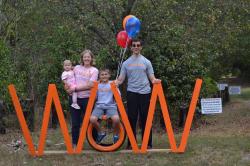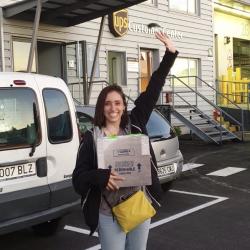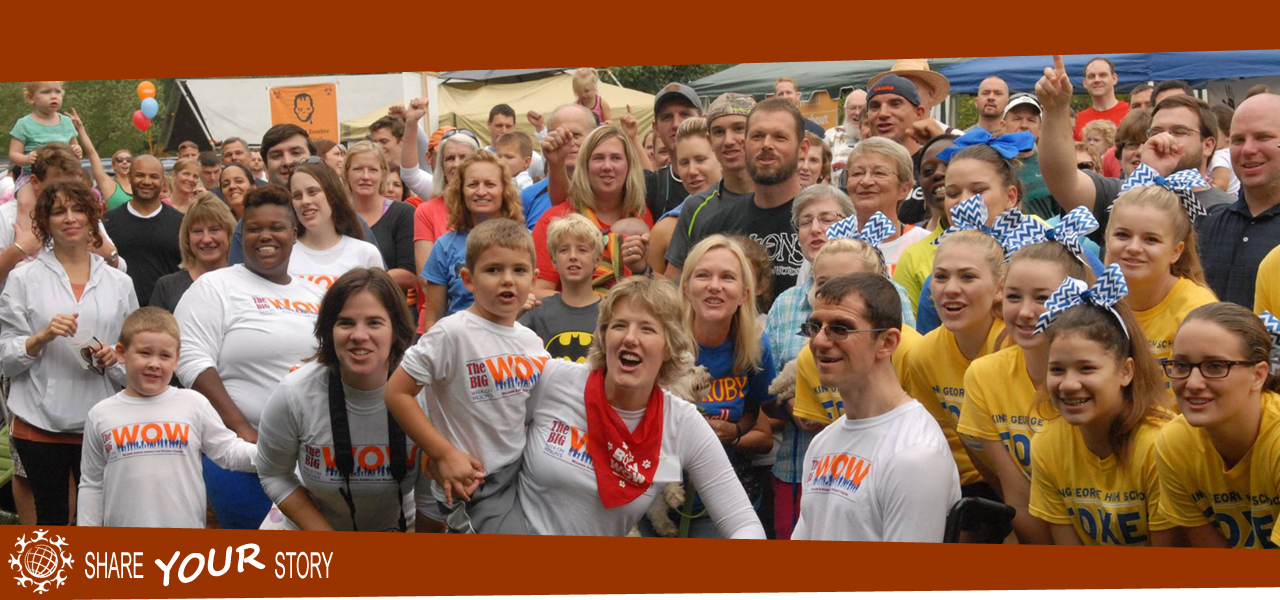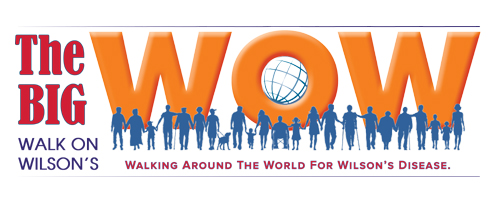Stories of warriors touched by Wilson’s Disease and how they fought back by rallying people they know to walk with them and raise money for the patient registry.
- Details
- Category: Wilson's Warriors
Hello,
In the middle of my junior year of high school, I went to the doctor for a normal, routine check-up. I found out I had high blood pressure, which was rare for a 16 year old, but I had no other obvious symptoms. Over the next six months, after many doctors appointments and inconclusive test results, finally an MRI of my liver showed scarring and abnormalities. After an eye doctor confirmed my Kaiser-Fleischer rings, my gastroenterologist was pretty quick to realize I needed a liver biopsy to confirm that I have Wilson's disease.
In six short months, I went from a healthy teenager, to a teenager who looks, acts, and feels healthy, but actually has liver fibrosis from a build-up of copper deposits. I am extremely lucky that my doctors investigated that high blood pressure number that never ended up being related to Wilson's disease. If it had been swept under the rug I could have had liver failiure a few years later. I am extremely lucky that I was both asymptomatic and had doctors that were able to find an accurate diagnosis quickly.
Many patients are not so lucky. Wilson's disease is a rare illness that manifests in different ways for every person, and it can be difficult to diagnose. The life saving medications needed to treat Wilson's Disease are not available in every country, and they are terribly expensive without financial assistance. I was very lucky to have the diagnosis and assistance that I did, but many others suffer with neurological or liver symptoms for years without a diagnosis or treatment.
I am writing this in hopes that we can raise awareness, fund more research for Wilson's disease and hopefully make treatment more widespread and affordable.
- Details
- Category: Wilson's Warriors
 Thank you for visiting our Langa Family Big WOW page!! To our new supporters, hello (!!) and please read our story (further below) about how Wilson's Disease (WD) has greatly impacted our lives over the last 10 years. To our supporters and attendees of previous years’ Big WOWs (hello to you, too!!), unfortunately, due to COVID-19 we are not holding an event that includes food, beverages, speakers and activities as we have in prior years. The national committee has gone fully virtual for the event this year; however, we have decided on the below for those that are interested:
Thank you for visiting our Langa Family Big WOW page!! To our new supporters, hello (!!) and please read our story (further below) about how Wilson's Disease (WD) has greatly impacted our lives over the last 10 years. To our supporters and attendees of previous years’ Big WOWs (hello to you, too!!), unfortunately, due to COVID-19 we are not holding an event that includes food, beverages, speakers and activities as we have in prior years. The national committee has gone fully virtual for the event this year; however, we have decided on the below for those that are interested:
The Langa Family with the help of the Friends of the Dahlgren Railroad Heritage Trail (DRHT) will have a small, informal walk on the Dahlgren Railroad Heritage Trail located at 10431 Bloomsbury Road in King George, Virginia to raise awareness for Wilson’s Disease. (For more information on the DRHT, please visit www.dahlgrentrail.org). The informal walk will be held on Saturday, October 3, 2020 at 1:00 p.m. Please remember to bring and WEAR YOUR MASK. We will also keep social distancing as a priority. No restroom facilities will be available at the trail. Donations will not be accepted in person at the walk. All donations towards Wilson's Disease should be made via this page. We appreciate your assistance in this as we all do our part not to spread COVID-19.
Please click the donate button (to the right) to donate and support the fight against Wilson's Disease. All funding will go towards the WD Patient Registry. "The Patient Registry creates a framework for advances in diagnosis, treatment and potential cures for the disease. Not only will the current generation of Wilson's Disease patients benefit , but this registry will serve as a roadmap for future generations to come." Please visit www.wilsonsdisease.org for more information. Please note that we will be accepting donations throughout the month of October. The donations link will be deactivated at 11:59p.m. on 10/31/2020.
OUR STORY:
For the past 10 years, Constantin Langa (now 37 years old) has been struggling with Wilson Disease (WD). Constantin's symptoms started when his son Traian was only 3 months old, and his wife, Nichole, and him were just learning how to be new parents.
Some of Constantin's first symptoms included excess saliva, toe and hand cramps, tongue and body tremors, dystonia, slurred speech, and balance loss (most all of which, he still struggles with today). It took him and his family 6 months from the start of his serious symptoms to get a diagnosis. By many measures though, they consider themselves very fortunate to have gotten a diagnosis within that timeframe, especially when others in the WD community were wrongly diagnosed or it took even longer for them to get a diagnosis. It was a very traumatic period for his family, as Constantin, a healthy and successful man, was falling apart, and his wife was taking care of a new baby. That “baby” (Traian) is now 10 years old, and Constantin and his wife were blessed with the birth of their second child (eight years later), a beautiful healthy girl named Adina, who is now 2 years old.
Part of the reason Constantin is a survivor is because he was diagnosed “early” enough to catch the fatal onset of the disease (although genetic testing at birth would have been the most ideal solution). However, getting a diagnosis was no easy matter. His family ran from doctor to doctor, and every time the doctors were either baffled, told them what Constantin didn’t have, or they were provided a wrong diagnosis. The first diagnosis they received was anxiety and depression, but they never gave up searching for answers because that just didn’t seem correct. His family knew that there was something more going on. It wasn't until he took an MRI, and the neurologist saw the "panda face" that Constantin was finally on the path toward a diagnosis. The MRI, plus lab and genetic testing, and the discovery of Kayser-Fleischer Rings in his eyes solidified the diagnosis. Thanks to a doctor at Johns Hopkins and assistance from a WD Center of Excellence doctor at Yale, they had an answer.
Over this period of about 6 to 8 months, the neurological manifestations of WD took Constantin suddenly from a very healthy, active lifestyle and holding a full-time job in Washington, D.C. to completely debilitating neurological effects of not being able to perform any basic function without assistance. Constantin's symptoms greatly worsened 3 weeks following the start of the chelation therapy medication. The doctors tried to save his liver by getting as much copper out of his body as quickly as possible. As a result, his neurological system was compromised.
Ten years into this WD journey, daily life is still a struggle and Constantin still requires 24-hour assistance from caregivers and family. However, his determination to get better means that even though he can't attend the regular therapies (aquatic, modified yoga, neurofeedback, acupuncture, acupressure, speech, etc.) he used to prior to COVID-19 (which has resulted in additional neurological challenges for him) he continues to push and try to overcome. Even these many years later, they are defying the odds and continue to see improvements.
Our hope is to raise awareness for WD, so that we can prevent future generations from the same devastating situation. Early diagnosis and treatment is the key! Thank you for supporting us and the WD community as we work together to better the lives of our fellow human beings!! Stay safe out there.
With Love, The Langa Family
- Details
- Category: Wilson's Warriors
 Hi, my name is Kayla Weselowski. My sister Chelsea and I were both diagnosed with Wilson's Disease in 2012. We live near Winnipeg, Manitoba, Canada.
Hi, my name is Kayla Weselowski. My sister Chelsea and I were both diagnosed with Wilson's Disease in 2012. We live near Winnipeg, Manitoba, Canada.
Chelsea is 29 years old and has severe brain and tissue damage from the disease as shown on multiple MRIs. She requires 24/7 care and has not been able to talk or move much since 2013. She was in the hospital for two years taking zinc, then tetrathiomolybdate which caused low WBC and several bouts of pneumonia, and now she currently takes trientine.
I am 26 years old and have chronic pain, anxiety, depression, scarred muscle tissue, and muscle tension/spasms. Initially, I presented with muscle pain and tension, a fatty and enlarged liver, fatigue and swelling. For treatment I tried the same sequence of medications as my sister, and I am currently taking trientine as well. I believe that this medication causes much of my abnormal muscle pain, tension and spasms as side effects of the drug, but treatment options are limited at this time.
My goal is to raise awareness about Wilson's Disease, and to fund research for diagnostics and new treatments that will greatly improve the quality of life for people all of the world that are living with this disease.
- Details
- Category: Wilson's Warriors
 Just when I expected to accomplish my goals and dreams, I started with an endless cycle of weird symptoms that worsened over time, like a cold dash of water poured on my life. I did not know what was happening to my body, and knew nothing but the fear that consumed me every day.
Just when I expected to accomplish my goals and dreams, I started with an endless cycle of weird symptoms that worsened over time, like a cold dash of water poured on my life. I did not know what was happening to my body, and knew nothing but the fear that consumed me every day.
Suddenly, on my first day of work at RedBull as a “Wing Girl” (driving a Mini Cooper and giving Red Bull samples to people around the city), a job I loved. My boss, Paulina, was giving me instructions. When I put my right elbow on the table, my hand had this slight tremor. I said to my boss, “sorry I was in a rush to get on time to work and did not have breakfast”. I got freaked out and thought maybe I was nervous?, but emotionally I was fine. I have an outgoing personality, so that is why it was so weird to shake. As time passed, my symptoms worsened little by little. I never gave up my job or school (I was studying Italian language).
Here it is a list of symptoms that I experienced, meds, and possible diagnoses that happened over this period of time, a whole year to be exact. I was 20 years old:
* Slight tremors in my extremities, my fingers moved by themselves – diagnosed with “Essential Tremors” and got prescribed “Propanolol”
* Stiffness on my fingers and toes
* Dropping saliva out of the blue
* Extreme emotions and strong tremors – diagnosed with Early Parkinson’s Diseases- doctors prescribed me Levodopa and Dopamine (Akineton and Sifrol) and Rivotril.
Feeling uncomprehended by myself, doctors, friends, family, school pals, work pals, my whole social life was crumbling. Especially at work, there were times that I felt excluded from work party events and my work pals. There were times that I sobbed uncontrollably, like when you grasp air and then an explosion of crying comes out like a ticking bomb. I was extremely sensitive and felt excluded and attacked. I felt watched and constantly tested at work and that was challenging. I remember my boss came with me to drive and watch me drive to test my performance and efficiency when giving samples. I did not blame her at all, she was worried and I thank her for giving me the opportunity to show that I was capable of persisting with my difficulties. They put me to work with girls I had some trouble getting along with. But in the end, we ended up laughing together. I gave my best.
Then there came a time at work where I could not open cans because of the strong tremors that made me extremely clumsy. Then I had another appointment with a private doctor. This doctor gave me the diagnosis of “Early Parkinson’s Disease”. I went to my boss’ office to talk to her, ”Pau, I cannot keep going. I do not know what is going to happen, I cannot keep working like this. I cannot drive anymore, I cannot open cans anymore, and I cannot give this image to the brand. I have been diagnosed with Parkinson’s Disease”. I remember that day, and it was very painful. She looked distraught, her eyes got watery, and she hugged me.
I stopped working after a year of constantly challenging situations. I remember that my work pals had complained about me not being able to drive. They had to alternate driving with me. I was falling asleep driving because of the Rivotril somnolence side effects (YES! Very dangerous, doctors never warned me).
I was destroyed inside. No hope about my future, just the curse of this “who knows what” disease I had. There was a time at school I could not grip a pencil to write and my teacher, Lara, told me to write as best I could with huge typography -ha ha! (Even with this challenge, I finished my Italian semester with a wonderful score).
Although still employed by Red Bull, I had stopped working. Then I had a brain resonance imaging done. That was the worst day of my life, because I received the worst mistaken diagnosis: “Amyotrophic lateral sclerosis (ALS)”. I sent a text to one of my bosses and said,
“Hey I finally got a diagnosis”. She said, “what is it?”
I said, “Amyotrophic lateral sclerosis (ALS)”
She did not reply back. I went home and searched on the internet, what the hell was ALS? I started reading and I all I wanted to do was die in that moment. I was thinking in asphyxiate myself with a plastic bag on my head. That was it, all i saw was my life vanishing, and I was devastated and my spirit was broken, I was living a nightmare.
The next evening, I received a call from the hospital. They said that WD was probably the correct diagnosis. Soon after, I had an appointment at one of the most prestigious medical institutes in Latin America (after trying with private doctors for a year). I felt like a laboratory rat, where a bunch of doctors were examining me in the exploration room. They looked at my eyes and BINGO! THE KAISER FLEISCHER RINGS WERE THERE! WILSONS DISEASE CONFIRMED!
After all the diseases I got diagnosed with, I am ok with having WD, the prognosis is good if you are disciplined with the lifetime maintenance treatment and i feel lucky that got diagnosed on time.
I now want to get more involved with WD events and I am joining this fundraising because thanks to this type of support I had access to Trientine (a very pricey treatment that I cannot afford), which the Wilsons Disease Organization and MAP donated me, as well, to create awareness about WD, for those who were misdiagnosed and died.
Thats me in the picture getting the Trientine out of UPS in Spain, all happy and grateful for having it finally in my hands.
Search Our Site
This website is not intended to provide advice on personal medical matters or to substitute for consultation with a physician. The WDA does not accept advertising for this website.
1732 First Avenue #20043. New York, NY. 10128 | 866-961-0533 or 414-961-0533
Terms of Use






